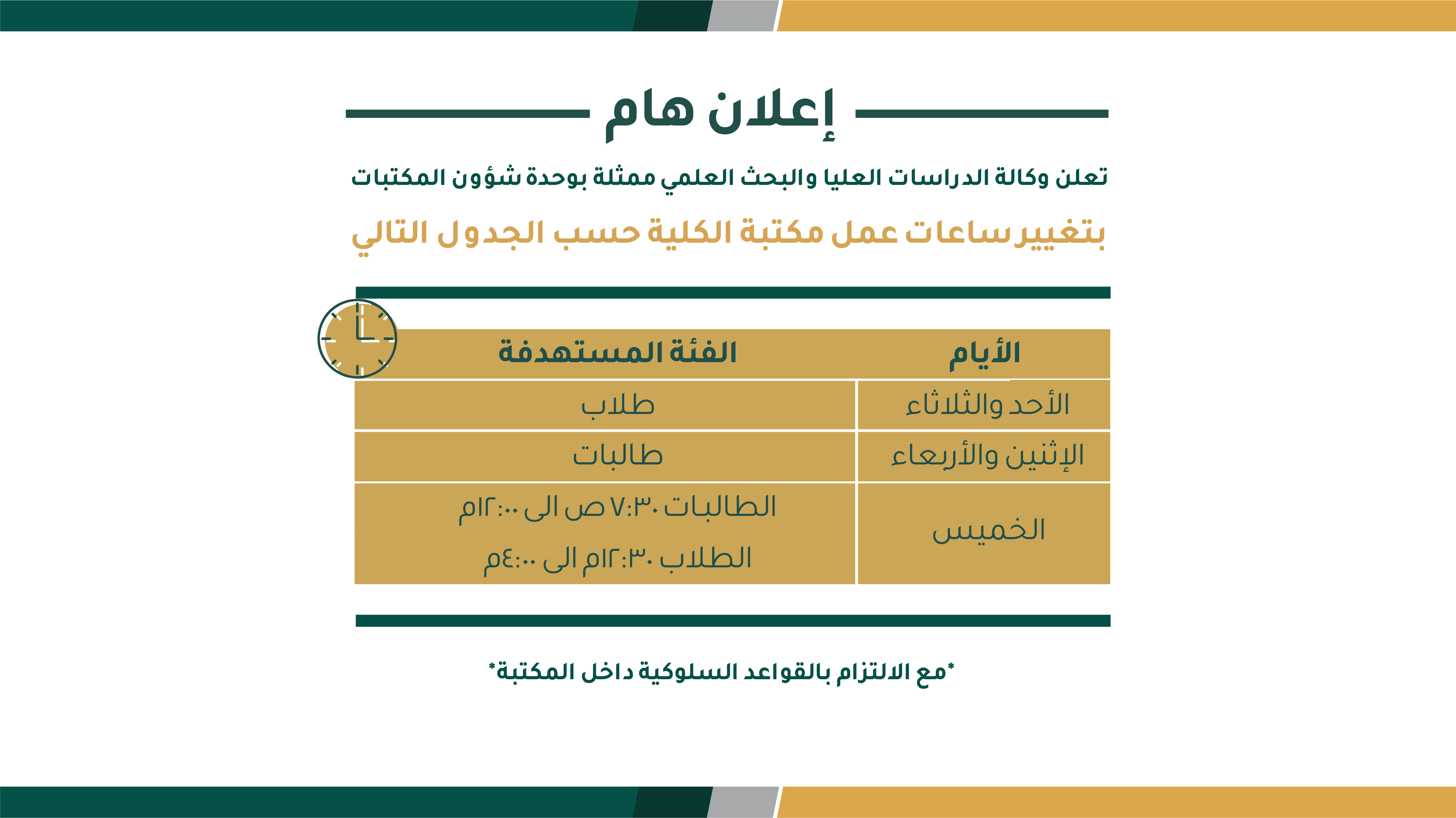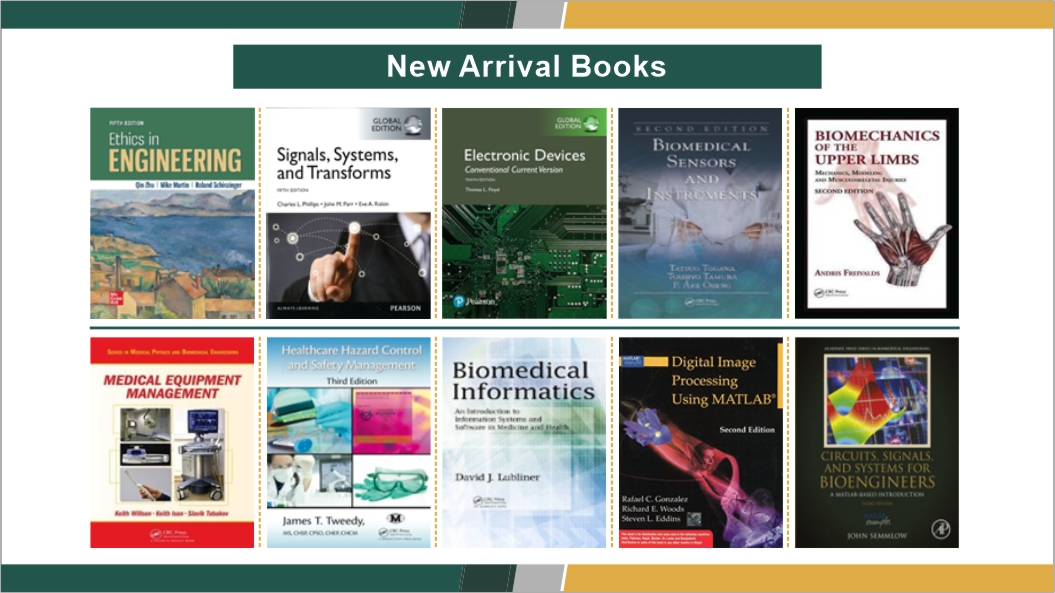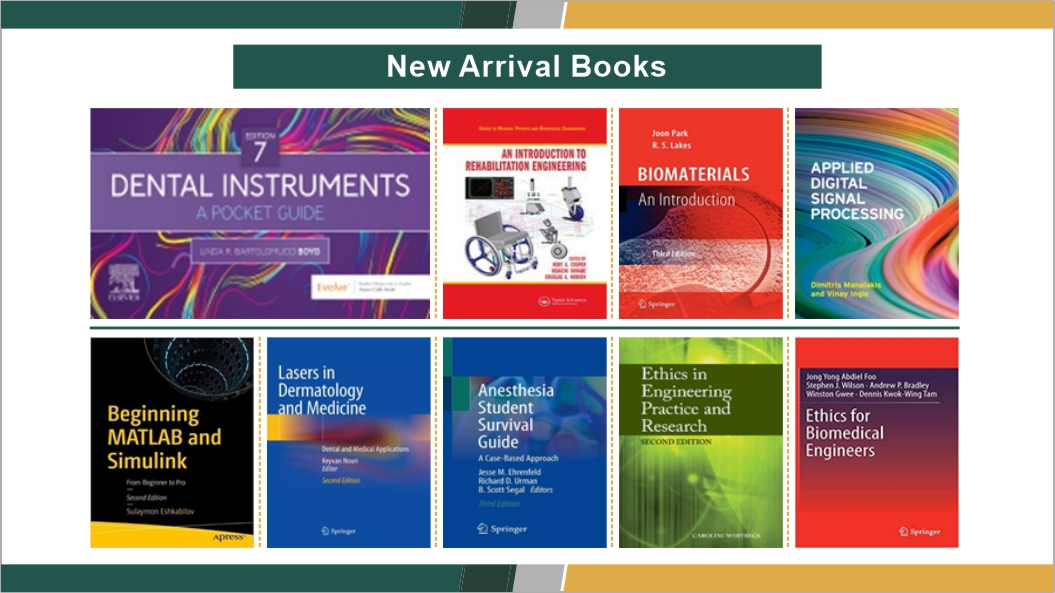
Signals and systems using MATLAB / Luis F. Chaparro, Aydin Akan.
Material type: TextEdition: Third editionDescription: xix, 816 pages : illustrations ; 24 cmISBN: 9780128142042Other title: Signals & systems using MATLABSubject(s): MATLAB | MATLAB | Signal processing -- Digital techniques | System analysis | Signal processing -- Digital techniques | System analysisDDC classification: 621.3822
TextEdition: Third editionDescription: xix, 816 pages : illustrations ; 24 cmISBN: 9780128142042Other title: Signals & systems using MATLABSubject(s): MATLAB | MATLAB | Signal processing -- Digital techniques | System analysis | Signal processing -- Digital techniques | System analysisDDC classification: 621.3822
Contents:
Machine generated contents note: ch. 0 From the Ground Up -- 0.1.Introduction -- 0.2.Examples of Signal Processing Applications -- 0.2.1.Compact-Disc (CD) Player -- 0.2.2.Software-Defined Radio and Cognitive Radio -- 0.2.3.Computer-Control Systems -- 0.3.Implementation of Digital Signal Processing Algorithms -- 0.3.1.Microprocessors and Micro-Controllers -- 0.3.2.Digital Signal Processors -- 0.3.3.Field Programmable Gate Arrays -- 0.4.Continuous or Discrete? -- 0.4.1.Continuous and Discrete Representations -- 0.4.2.Derivatives and Finite Differences -- 0.4.3.Integrals and Summations -- 0.4.4.Differential and Difference Equations -- 0.5.Complex or Real? -- 0.5.1.Complex Numbers and Vectors -- 0.5.2.Functions of a Complex Variable -- 0.5.3.Phasors and Sinusoidal Steady State -- 0.5.4.The Phasor Connection -- 0.6.Soft Introduction to MATLAB -- 0.6.1.Numerical Computations -- 0.6.2.Symbolic Computations -- 0.7.Problems -- 0.7.1.Basic Problems -- 0.7.2.Problems Using MATLAB -- ch. 1 Continuous-Time Signals -- 1.1.Introduction -- 1.2.Classification of Time-Dependent Signals -- 1.3.Continuous-Time Signals -- 1.3.1.Addition, Constant Multiplication, Time Shifting and Reflection -- 1.3.2.Even and Odd Signals -- 1.3.3.Periodic and Aperiodic Signals -- 1.3.4.Finite-Energy and Finite-Power Signals -- 1.4.Representation of Continuous-Time Signals Using Basic Signals -- 1.4.1.Complex Exponentials -- 1.4.2.Unit Step, Unit Impulse and Ramp Signals -- 1.4.3.Generic Representation of Signals -- 1.5.Time Scaling, Modulation, Windowing and Integration -- 1.6.Special Signals-the Sampling and the Sinc Signals -- 1.7.What Have We Accomplished? Where Do We Go From Here? -- 1.8.Problems -- 1.8.1.Basic Problems -- 1.8.2.Problems Using MATLAB -- ch. 2 Continuous-lime Systems -- 2.1.Introduction -- 2.2.System Concept and Classification -- 2.3.Linear Time-Invariant (LTI) Continuous-Time Systems -- 2.3.1.Linearity -- 2.3.2.Time-Invariance -- 2.3.3.Representation of Systems by Ordinary Differential Equations -- 2.4.The Convolution Integral -- 2.4.1.Impulse Response and Convolution Integral -- 2.4.2.Interconnection of Systems-Block Diagrams -- 2.5.Causality -- 2.5.1.Graphical Computation of Convolution Integral -- 2.6.Bounded Input-Bounded Output Stability -- 2.7.What Have We Accomplished? Where Do We Go From Here? -- 2.8.Problems -- 2.8.1.Basic Problems -- 2.8.2.Problems Using MATLAB -- ch. 3 The Laplace Transform -- 3.1.Introduction -- 3.2.The Two-Sided Laplace Transform -- 3.2.1.Eigenfunctions of LTI Systems -- 3.2.2.Region of Convergence -- 3.3.The One-Sided Laplace Transform -- 3.4.Properties of the One-Sided Laplace Transform -- 3.4.1.Linearity -- 3.4.2.Differentiation -- 3.4.3.Integration -- 3.4.4.Time-Shifting -- 3.4.5.Duality -- 3.4.6.Convolution Integral -- 3.5.Inverse Laplace Transform -- 3.5.1.Inverse of One-Sided Laplace Transforms -- 3.5.2.Inverse of Functions Containing e-Ps Terms -- 3.6.The Transfer Function of LTI Systems -- 3.7.Analysis of LTI Systems Represented by Differential Equations -- 3.8.Inverse of Two-Sided Laplace Transforms -- 3.9.What Have We Accomplished? Where Do We Go From Here? -- 3.10.Problems -- 3.10.1.Basic Problems -- 3.10.2.Problem Using MATLAB -- ch. 4 Frequency Analysis: The Fourier Series -- 4.1.Introduction -- 4.2.Eigenfunctions Revisited -- 4.3.Complex Exponential Fourier Series -- 4.3.1.Line Spectrum-Power Distribution Over Frequency -- 4.3.2.Trigonometric Fourier Series -- 4.3.3.Fourier Series and Laplace Transform -- 4.3.4.Reflection and Even and Odd Periodic Signals -- 4.3.5.Convergence of the Fourier Series -- 4.3.6.Time and Frequency Shifting -- 4.4.Response of LTI Systems to Periodic Signals -- 4.4.1.Filtering of Periodic Signals -- 4.5.Operations Using Fourier Series -- 4.5.1.Sum of Periodic Signals -- 4.5.2.Multiplication of Periodic Signals -- 4.5.3.Derivatives and Integrals of Periodic Signals -- 4.5.4.Amplitude and Time Scaling of Periodic Signals -- 4.6.What Have We Accomplished? Where Do We Go From Here? -- 4.7.Problems -- 4.7.1.Basic Problems -- 4.7.2.Problems Using MATLAB -- ch. 5 Frequency Analysis: The Fourier Transform -- 5.1.Introduction -- 5.2.From the Fourier Series to the Fourier Transform -- 5.3.Existence of the Fourier Transform -- 5.4.Fourier Transforms From the Laplace Transform -- 5.5.Linearity, Inverse Proportionality and Duality -- 5.5.1.Linearity -- 5.5.2.Inverse Proportionality of lime and Frequency -- 5.5.3.Duality -- 5.6.Spectral Representation -- 5.6.1.Signal Modulation -- 5.6.2.Fourier Transform of Periodic Signals -- 5.6.3.Parseval's Energy Relation -- 5.6.4.Symmetry of Spectral Representations -- 5.7.Convolution and Filtering -- 5.7.1.Basics of Filtering -- 5.7.2.Ideal Filters -- 5.7.3.Frequency Response From Poles and Zeros -- 5.7.4.The Spectrum Analyzer -- 5.8.Additional Properties -- 5.8.1.Time Shifting -- 5.8.2.Differentiation and Integration -- 5.9.What Have We Accomplished? What Is Next? -- 5.10.Problems -- 5.10.1.Basic Problems -- 5.10.2.Problems Using MATLAB -- ch. 6 Application of Laplace Analysis to Control -- 6.1.Introduction -- 6.2.System Connections and Block Diagrams -- 6.3.Application to Classical Control -- 6.3.1.Stability and Stabilization -- 6.3.2.Transient Analysis of First- and Second-Order Control Systems -- 6.4.State-Variable Representation of LTI Systems -- 6.4.1.Canonical Realizations -- 6.4.2.Complete Solution From State and Output Equations -- 6.4.3.External and Internal Representation of Systems -- 6.5.What Have We Accomplished? What Is Next? -- 6.6.Problems -- 6.6.1.Basic Problems -- 6.6.2.Problems Using MATLAB -- ch. 7 Fourier Analysis in Communications and Filtering -- 7.1.Introduction -- 7.2.Application to Communications -- 7.2.1.AM Suppressed Carrier (AM-SC) -- 7.2.2.Commercial AM -- 7.2.3.AM Single Sideband -- 7.2.4.Quadrature AM and Frequency Division Multiplexing -- 7.2.5.Angle Modulation -- 7.3.Analog Filtering -- 7.3.1.Filtering Basics -- 7.3.2.Butterworth Low-Pass Filter Design -- 7.3.3.Chebyshev Low-Pass Filter Design -- 7.3.4.Frequency Transformations -- 7.3.5.Filter Design With MATLAB -- 7.4.What Have We Accomplished? What Is Next? -- 7.5.Problems -- 7.5.1.Basic Problems -- 7.5.2.Problems Using MATLAB -- ch. 8 Sampling Theory -- 8.1.Introduction -- 8.2.Uniform Sampling -- 8.2.1.Pulse Amplitude Modulation -- 8.2.2.Ideal Impulse Sampling -- 8.2.3.Reconstruction of the Original Continuous-Time Signal -- 8.2.4.Signal Reconstruction From Sinc Interpolation -- 8.2.5.The Nyquist-Shannon Sampling Theorem -- 8.2.6.Sampling Simulations With MATLAB -- 8.2.7.Sampling Modulated Signals -- 8.3.Practical Aspects of Sampling -- 8.3.1.Sample-and-Hold Sampling -- 8.3.2.Quantization and Coding -- 8.3.3.Sampling, Quantizing and Coding With MATLAB -- 8.4.Application to Digital Communications -- 8.4.1.Pulse Code Modulation -- 8.4.2.Time-Division Multiplexing -- 8.5.What Have We Accomplished? Where Do We Go From Here? -- 8.6.Problems -- 8.6.1.Basic Problems -- 8.6.2.Problems Using MATLAB -- ch. 9 Discrete-Time Signals and Systems -- 9.1.Introduction -- 9.2.Discrete-Time Signals -- 9.2.1.Periodic and Aperiodic Discrete-Time Signals -- 9.2.2.Finite-Energy and Finite-Power Discrete-Time Signals -- 9.2.3.Even and Odd Discrete-Time Signals -- 9.2.4.Basic Discrete-Time Signals -- 9.3.Discrete-Time Systems -- 9.3.1.Recursive and Non-recursive Discrete-Time Systems -- 9.3.2.Dynamic Discrete-Time Systems Represented by Difference Equations -- 9.3.3.The Convolution Sum -- 9.3.4.Linear and Non-linear Filtering With MATLAB -- 9.3.5.Causality and Stability of Discrete-Time Systems -- 9.4.Two-Dimensional Discrete Signals and Systems -- 9.4.1.Two-Dimensional Discrete Signals -- 9.4.2.Two-Dimensional Discrete Systems -- 9.5.What Have We Accomplished? Where Do We Go From Here? -- 9.6.Problems -- 9.6.1.Basic Problems -- 9.6.2.Problems Using MATLAB -- ch. 10 The Z-transform -- 10.1.Introduction -- 10.2.Laplace Transform of Sampled Signals -- 10.3.Two-Sided Z-transform -- 10.3.1.Region of Convergence -- 10.4.One-Sided Z-transform -- 10.4.1.Signal Behavior and Poles -- 10.4.2.Computing Z-transforms With Symbolic MATLAB -- 10.4.3.Convolution Sum and Transfer Function -- 10.4.4.Interconnection of Discrete-Time Systems -- 10.4.5.Initial- and Final-Value Properties -- 10.5.One-Sided Z-transform Inverse -- 10.5.1.Long-Division Method -- 10.5.2.Partial Fraction Expansion -- 10.5.3.Inverse Z-transform With MATLAB -- 10.5.4.Solution of Difference Equations -- 10.5.5.Inverse of Two-Sided Z-transforms -- 10.6.State Variable Representation -- 10.7.Two-Dimensional Z-transform -- 10.8.What Have We Accomplished? Where Do We Go From Here? -- 10.9.Problems -- 10.9.1.Basic Problems -- 10.9.2.Problems Using MATLAB -- ch. 11 Discrete Fourier Analysis -- 11.1.Introduction -- 11.2.The Discrete-Time Fourier Transform (DTFT) -- 11.2.1.Sampling, Z-transform, Eigenfunctions and the DTFT -- 11.2.2.Duality in Time and in Frequency -- 11.2.3.Computation of the DTFT Using MATLAB -- 11.2.4.Time and Frequency Supports -- 11.2.5.Decimation and Interpolation -- 11.2.6.Energy/Power of Aperiodic Discrete-Time Signals -- 11.2.7.Time and Frequency Shifts -- 11.2.8.Symmetry -- 11.2.9.Convolution Sum -- 11.3.Fourier Series of Discrete-Time Periodic Signals -- 11.3.1.Complex Exponential Discrete Fourier Series -- 11.3.2.Connection With the Z-transform -- 11.3.3.DTFT of Periodic Signals -- 11.3.4.Response of LTI Systems to Periodic Signals -- 11.3.5.Circular Shifting and Periodic Convolution -- 11.4.The Discrete Fourier Transform (DFT) -- 11.4.1.DFT of Periodic Discrete-Time Signals -- 11.4.2.DFT of Aperiodic Discrete-Time Signals -- 11.4.3.Computation of the DFT via the FFT -- 11.4.4.Linear and Circular Convolution -- 11.4.5.The Fast Fourier Transform Algorithm -- 11.4.6.Computation of the Inverse DFT -- 11.5.Two-Dimensional Discrete Transforms -- 11.6.What Have We Accomplished? Where Do We Go From Here? -- 11.7.Problems -- 11.7.1.Basic Problems -- 11.7.2.Problems Using MATLAB
Note continued: ch. 12 Introduction to the Design of Discrete Filters -- 12.1.Introduction -- 12.2.Frequency Selective Discrete Filters -- 12.2.1.Phase Distortion -- 12.2.2.IIR and FIR Discrete Filters -- 12.3.Filter Specifications -- 12.3.1.Frequency Specifications -- 12.3.2.Time Domain Specifications -- 12.4.IIR Filter Design -- 12.4.1.Transformation Design of IIR Discrete Filters -- 12.4.2.Design of Butterworth Low-Pass Discrete Filters -- 12.4.3.Design of Chebyshev Low-Pass Discrete Filters -- 12.4.4.Rational Frequency Transformations -- 12.4.5.General IIR Filter Design With MATLAB -- 12.5.FIR Filter Design -- 12.5.1.Window Design Method -- 12.5.2.Window Functions -- 12.5.3.Linear Phase and Symmetry of the Impulse Response -- 12.6.Realization of Discrete Filters -- 12.6.1.Realization of 1W Filters -- 12.6.2.Realization of FIR Filters -- 12.7.Two-Dimensional Filtering of Images -- 12.7.1.Spatial Filtering -- 12.7.2.Frequency Domain Filtering -- 12.8.What Have We Accomplished? Where Do We Go From Here? -- 12.9.Problems -- 12.9.1.Basic Problems -- 12.9.2.Problems Using MATLAB -- Trigonometric Relations -- Calculus.
| Item type | Home library | Collection | Call number | Copy number | Status | Date due | Barcode | Item holds |
|---|---|---|---|---|---|---|---|---|
 Books
Books
|
Prince Sultan Military College of Health Sciences, Library | Biomedical Technology | 621.3822 C43 (Browse shelf (Opens below)) | 1 | Not For Loan (Restricted Access) | 0000000027831 | ||
 Books
Books
|
Prince Sultan Military College of Health Sciences, Library | Biomedical Technology | 621.3822 C43 (Browse shelf (Opens below)) | 2 | Available | 0000000027832 | ||
 Books
Books
|
Prince Sultan Military College of Health Sciences, Library | Biomedical Technology | 621.3822 C43 (Browse shelf (Opens below)) | 3 | Available | 0000000027833 | ||
 Books
Books
|
Prince Sultan Military College of Health Sciences, Library | Biomedical Technology | 621.3822 C43 (Browse shelf (Opens below)) | 4 | Available | 0000000027834 | ||
 Books
Books
|
Prince Sultan Military College of Health Sciences, Library | Biomedical Technology | 621.3822 C43 (Browse shelf (Opens below)) | 5 | Available | 0000000027835 |
Total holds: 0
Includes bibliographical references and index.
Machine generated contents note: ch. 0 From the Ground Up -- 0.1.Introduction -- 0.2.Examples of Signal Processing Applications -- 0.2.1.Compact-Disc (CD) Player -- 0.2.2.Software-Defined Radio and Cognitive Radio -- 0.2.3.Computer-Control Systems -- 0.3.Implementation of Digital Signal Processing Algorithms -- 0.3.1.Microprocessors and Micro-Controllers -- 0.3.2.Digital Signal Processors -- 0.3.3.Field Programmable Gate Arrays -- 0.4.Continuous or Discrete? -- 0.4.1.Continuous and Discrete Representations -- 0.4.2.Derivatives and Finite Differences -- 0.4.3.Integrals and Summations -- 0.4.4.Differential and Difference Equations -- 0.5.Complex or Real? -- 0.5.1.Complex Numbers and Vectors -- 0.5.2.Functions of a Complex Variable -- 0.5.3.Phasors and Sinusoidal Steady State -- 0.5.4.The Phasor Connection -- 0.6.Soft Introduction to MATLAB -- 0.6.1.Numerical Computations -- 0.6.2.Symbolic Computations -- 0.7.Problems -- 0.7.1.Basic Problems -- 0.7.2.Problems Using MATLAB -- ch. 1 Continuous-Time Signals -- 1.1.Introduction -- 1.2.Classification of Time-Dependent Signals -- 1.3.Continuous-Time Signals -- 1.3.1.Addition, Constant Multiplication, Time Shifting and Reflection -- 1.3.2.Even and Odd Signals -- 1.3.3.Periodic and Aperiodic Signals -- 1.3.4.Finite-Energy and Finite-Power Signals -- 1.4.Representation of Continuous-Time Signals Using Basic Signals -- 1.4.1.Complex Exponentials -- 1.4.2.Unit Step, Unit Impulse and Ramp Signals -- 1.4.3.Generic Representation of Signals -- 1.5.Time Scaling, Modulation, Windowing and Integration -- 1.6.Special Signals-the Sampling and the Sinc Signals -- 1.7.What Have We Accomplished? Where Do We Go From Here? -- 1.8.Problems -- 1.8.1.Basic Problems -- 1.8.2.Problems Using MATLAB -- ch. 2 Continuous-lime Systems -- 2.1.Introduction -- 2.2.System Concept and Classification -- 2.3.Linear Time-Invariant (LTI) Continuous-Time Systems -- 2.3.1.Linearity -- 2.3.2.Time-Invariance -- 2.3.3.Representation of Systems by Ordinary Differential Equations -- 2.4.The Convolution Integral -- 2.4.1.Impulse Response and Convolution Integral -- 2.4.2.Interconnection of Systems-Block Diagrams -- 2.5.Causality -- 2.5.1.Graphical Computation of Convolution Integral -- 2.6.Bounded Input-Bounded Output Stability -- 2.7.What Have We Accomplished? Where Do We Go From Here? -- 2.8.Problems -- 2.8.1.Basic Problems -- 2.8.2.Problems Using MATLAB -- ch. 3 The Laplace Transform -- 3.1.Introduction -- 3.2.The Two-Sided Laplace Transform -- 3.2.1.Eigenfunctions of LTI Systems -- 3.2.2.Region of Convergence -- 3.3.The One-Sided Laplace Transform -- 3.4.Properties of the One-Sided Laplace Transform -- 3.4.1.Linearity -- 3.4.2.Differentiation -- 3.4.3.Integration -- 3.4.4.Time-Shifting -- 3.4.5.Duality -- 3.4.6.Convolution Integral -- 3.5.Inverse Laplace Transform -- 3.5.1.Inverse of One-Sided Laplace Transforms -- 3.5.2.Inverse of Functions Containing e-Ps Terms -- 3.6.The Transfer Function of LTI Systems -- 3.7.Analysis of LTI Systems Represented by Differential Equations -- 3.8.Inverse of Two-Sided Laplace Transforms -- 3.9.What Have We Accomplished? Where Do We Go From Here? -- 3.10.Problems -- 3.10.1.Basic Problems -- 3.10.2.Problem Using MATLAB -- ch. 4 Frequency Analysis: The Fourier Series -- 4.1.Introduction -- 4.2.Eigenfunctions Revisited -- 4.3.Complex Exponential Fourier Series -- 4.3.1.Line Spectrum-Power Distribution Over Frequency -- 4.3.2.Trigonometric Fourier Series -- 4.3.3.Fourier Series and Laplace Transform -- 4.3.4.Reflection and Even and Odd Periodic Signals -- 4.3.5.Convergence of the Fourier Series -- 4.3.6.Time and Frequency Shifting -- 4.4.Response of LTI Systems to Periodic Signals -- 4.4.1.Filtering of Periodic Signals -- 4.5.Operations Using Fourier Series -- 4.5.1.Sum of Periodic Signals -- 4.5.2.Multiplication of Periodic Signals -- 4.5.3.Derivatives and Integrals of Periodic Signals -- 4.5.4.Amplitude and Time Scaling of Periodic Signals -- 4.6.What Have We Accomplished? Where Do We Go From Here? -- 4.7.Problems -- 4.7.1.Basic Problems -- 4.7.2.Problems Using MATLAB -- ch. 5 Frequency Analysis: The Fourier Transform -- 5.1.Introduction -- 5.2.From the Fourier Series to the Fourier Transform -- 5.3.Existence of the Fourier Transform -- 5.4.Fourier Transforms From the Laplace Transform -- 5.5.Linearity, Inverse Proportionality and Duality -- 5.5.1.Linearity -- 5.5.2.Inverse Proportionality of lime and Frequency -- 5.5.3.Duality -- 5.6.Spectral Representation -- 5.6.1.Signal Modulation -- 5.6.2.Fourier Transform of Periodic Signals -- 5.6.3.Parseval's Energy Relation -- 5.6.4.Symmetry of Spectral Representations -- 5.7.Convolution and Filtering -- 5.7.1.Basics of Filtering -- 5.7.2.Ideal Filters -- 5.7.3.Frequency Response From Poles and Zeros -- 5.7.4.The Spectrum Analyzer -- 5.8.Additional Properties -- 5.8.1.Time Shifting -- 5.8.2.Differentiation and Integration -- 5.9.What Have We Accomplished? What Is Next? -- 5.10.Problems -- 5.10.1.Basic Problems -- 5.10.2.Problems Using MATLAB -- ch. 6 Application of Laplace Analysis to Control -- 6.1.Introduction -- 6.2.System Connections and Block Diagrams -- 6.3.Application to Classical Control -- 6.3.1.Stability and Stabilization -- 6.3.2.Transient Analysis of First- and Second-Order Control Systems -- 6.4.State-Variable Representation of LTI Systems -- 6.4.1.Canonical Realizations -- 6.4.2.Complete Solution From State and Output Equations -- 6.4.3.External and Internal Representation of Systems -- 6.5.What Have We Accomplished? What Is Next? -- 6.6.Problems -- 6.6.1.Basic Problems -- 6.6.2.Problems Using MATLAB -- ch. 7 Fourier Analysis in Communications and Filtering -- 7.1.Introduction -- 7.2.Application to Communications -- 7.2.1.AM Suppressed Carrier (AM-SC) -- 7.2.2.Commercial AM -- 7.2.3.AM Single Sideband -- 7.2.4.Quadrature AM and Frequency Division Multiplexing -- 7.2.5.Angle Modulation -- 7.3.Analog Filtering -- 7.3.1.Filtering Basics -- 7.3.2.Butterworth Low-Pass Filter Design -- 7.3.3.Chebyshev Low-Pass Filter Design -- 7.3.4.Frequency Transformations -- 7.3.5.Filter Design With MATLAB -- 7.4.What Have We Accomplished? What Is Next? -- 7.5.Problems -- 7.5.1.Basic Problems -- 7.5.2.Problems Using MATLAB -- ch. 8 Sampling Theory -- 8.1.Introduction -- 8.2.Uniform Sampling -- 8.2.1.Pulse Amplitude Modulation -- 8.2.2.Ideal Impulse Sampling -- 8.2.3.Reconstruction of the Original Continuous-Time Signal -- 8.2.4.Signal Reconstruction From Sinc Interpolation -- 8.2.5.The Nyquist-Shannon Sampling Theorem -- 8.2.6.Sampling Simulations With MATLAB -- 8.2.7.Sampling Modulated Signals -- 8.3.Practical Aspects of Sampling -- 8.3.1.Sample-and-Hold Sampling -- 8.3.2.Quantization and Coding -- 8.3.3.Sampling, Quantizing and Coding With MATLAB -- 8.4.Application to Digital Communications -- 8.4.1.Pulse Code Modulation -- 8.4.2.Time-Division Multiplexing -- 8.5.What Have We Accomplished? Where Do We Go From Here? -- 8.6.Problems -- 8.6.1.Basic Problems -- 8.6.2.Problems Using MATLAB -- ch. 9 Discrete-Time Signals and Systems -- 9.1.Introduction -- 9.2.Discrete-Time Signals -- 9.2.1.Periodic and Aperiodic Discrete-Time Signals -- 9.2.2.Finite-Energy and Finite-Power Discrete-Time Signals -- 9.2.3.Even and Odd Discrete-Time Signals -- 9.2.4.Basic Discrete-Time Signals -- 9.3.Discrete-Time Systems -- 9.3.1.Recursive and Non-recursive Discrete-Time Systems -- 9.3.2.Dynamic Discrete-Time Systems Represented by Difference Equations -- 9.3.3.The Convolution Sum -- 9.3.4.Linear and Non-linear Filtering With MATLAB -- 9.3.5.Causality and Stability of Discrete-Time Systems -- 9.4.Two-Dimensional Discrete Signals and Systems -- 9.4.1.Two-Dimensional Discrete Signals -- 9.4.2.Two-Dimensional Discrete Systems -- 9.5.What Have We Accomplished? Where Do We Go From Here? -- 9.6.Problems -- 9.6.1.Basic Problems -- 9.6.2.Problems Using MATLAB -- ch. 10 The Z-transform -- 10.1.Introduction -- 10.2.Laplace Transform of Sampled Signals -- 10.3.Two-Sided Z-transform -- 10.3.1.Region of Convergence -- 10.4.One-Sided Z-transform -- 10.4.1.Signal Behavior and Poles -- 10.4.2.Computing Z-transforms With Symbolic MATLAB -- 10.4.3.Convolution Sum and Transfer Function -- 10.4.4.Interconnection of Discrete-Time Systems -- 10.4.5.Initial- and Final-Value Properties -- 10.5.One-Sided Z-transform Inverse -- 10.5.1.Long-Division Method -- 10.5.2.Partial Fraction Expansion -- 10.5.3.Inverse Z-transform With MATLAB -- 10.5.4.Solution of Difference Equations -- 10.5.5.Inverse of Two-Sided Z-transforms -- 10.6.State Variable Representation -- 10.7.Two-Dimensional Z-transform -- 10.8.What Have We Accomplished? Where Do We Go From Here? -- 10.9.Problems -- 10.9.1.Basic Problems -- 10.9.2.Problems Using MATLAB -- ch. 11 Discrete Fourier Analysis -- 11.1.Introduction -- 11.2.The Discrete-Time Fourier Transform (DTFT) -- 11.2.1.Sampling, Z-transform, Eigenfunctions and the DTFT -- 11.2.2.Duality in Time and in Frequency -- 11.2.3.Computation of the DTFT Using MATLAB -- 11.2.4.Time and Frequency Supports -- 11.2.5.Decimation and Interpolation -- 11.2.6.Energy/Power of Aperiodic Discrete-Time Signals -- 11.2.7.Time and Frequency Shifts -- 11.2.8.Symmetry -- 11.2.9.Convolution Sum -- 11.3.Fourier Series of Discrete-Time Periodic Signals -- 11.3.1.Complex Exponential Discrete Fourier Series -- 11.3.2.Connection With the Z-transform -- 11.3.3.DTFT of Periodic Signals -- 11.3.4.Response of LTI Systems to Periodic Signals -- 11.3.5.Circular Shifting and Periodic Convolution -- 11.4.The Discrete Fourier Transform (DFT) -- 11.4.1.DFT of Periodic Discrete-Time Signals -- 11.4.2.DFT of Aperiodic Discrete-Time Signals -- 11.4.3.Computation of the DFT via the FFT -- 11.4.4.Linear and Circular Convolution -- 11.4.5.The Fast Fourier Transform Algorithm -- 11.4.6.Computation of the Inverse DFT -- 11.5.Two-Dimensional Discrete Transforms -- 11.6.What Have We Accomplished? Where Do We Go From Here? -- 11.7.Problems -- 11.7.1.Basic Problems -- 11.7.2.Problems Using MATLAB
Note continued: ch. 12 Introduction to the Design of Discrete Filters -- 12.1.Introduction -- 12.2.Frequency Selective Discrete Filters -- 12.2.1.Phase Distortion -- 12.2.2.IIR and FIR Discrete Filters -- 12.3.Filter Specifications -- 12.3.1.Frequency Specifications -- 12.3.2.Time Domain Specifications -- 12.4.IIR Filter Design -- 12.4.1.Transformation Design of IIR Discrete Filters -- 12.4.2.Design of Butterworth Low-Pass Discrete Filters -- 12.4.3.Design of Chebyshev Low-Pass Discrete Filters -- 12.4.4.Rational Frequency Transformations -- 12.4.5.General IIR Filter Design With MATLAB -- 12.5.FIR Filter Design -- 12.5.1.Window Design Method -- 12.5.2.Window Functions -- 12.5.3.Linear Phase and Symmetry of the Impulse Response -- 12.6.Realization of Discrete Filters -- 12.6.1.Realization of 1W Filters -- 12.6.2.Realization of FIR Filters -- 12.7.Two-Dimensional Filtering of Images -- 12.7.1.Spatial Filtering -- 12.7.2.Frequency Domain Filtering -- 12.8.What Have We Accomplished? Where Do We Go From Here? -- 12.9.Problems -- 12.9.1.Basic Problems -- 12.9.2.Problems Using MATLAB -- Trigonometric Relations -- Calculus.
















There are no comments on this title.